The Republic of Ireland occupies most of the island of Ireland, off the coast of England and Wales. Its capital, Dublin, is the birthplace of writers like Oscar Wilde, and home of Guinness beer. The 9th-century Book of Kells and other illustrated manuscripts are on show in Dublin’s Trinity College Library. Dubbed the “Emerald Isle” for its lush landscape, the country is dotted with castles like medieval Cahir Castle.
The geography of Ireland comprises relatively low-lying mountains surrounding a central plain, with several navigable rivers extending inland. Its lush vegetation is a product of its mild but changeable climate which is free of extremes in temperature. Much of Ireland was woodland until the end of the Middle Ages. Today, woodland makes up about 10% of the island, compared with a European average of over 33%, and most of it is non-native conifer plantations. There are twenty-six extant land mammal species native to Ireland.The Irish climate is influenced by the Atlantic Ocean and thus very moderate, and winters are milder than expected for such a northerly area, although summers are cooler than those in continental Europe. Rainfall and cloud cover are abundant.
Irish culture has had a significant influence on other cultures, especially in the field of literature. Alongside mainstream Western culture, a strong indigenous culture exists, as expressed through Gaelic games, Irish music, Irish language, and Irish dance. The island’s culture shares many features with that of Great Britain, including the English language, and sports such as association football, rugby, horse racing, golf, and boxing.
Some of the most visited sites in Ireland include Bunratty Castle, the Rock of Cashel, the Cliffs of Moher, Holy Cross Abbey and Blarney Castle. Historically important monastic sites include Glendalough and Clonmacnoise, which are maintained as national monuments in the Republic of Ireland.
The Dublin region receives the most tourists and is home to several of the most popular attractions such as the Guinness Storehouse and Book of Kells. The west and south west, which includes the Lakes of Killarney and the Dingle peninsula in County Kerry and Connemara and the Aran Islands in County Galway, are also popular tourist destinations.
Achill Island lies off the coast of County Mayo and is Ireland’s largest island. It is a popular tourist destination for surfing and contains 5 Blue Flag beaches and Croaghaun one of the worlds highest sea cliffs.
1.The Cliffs of Moher

The Cliffs of Moher are sea cliffs located at the southwestern edge of the Burren region in County Clare, Ireland. They run for about 14 kilometres.
From the cliffs, and from atop the tower, visitors can see the Aran Islands in Galway Bay, the Maumturks and Twelve Pins mountain ranges to the north in County Galway, and Loop Head to the south. The cliffs rank among the most visited tourist sites in Ireland, with around 1.5 million visits per year.
The cliffs are one of the most popular tourist destinations in Ireland and topped a list of attractions in 2006 by receiving almost one million visitors at the official visitor centre. With additional visitors to other locales included there are around 1.5 million a year.Since 2011, they have formed a part of the Burren and Cliffs of Moher Geopark, one of a family of geotourism destinations throughout Europe that are members of the European Geoparks Network and also recognized by UNESCO. The cliffs are also a “signature point” on the official Wild Atlantic Way tourist trail.
While the cliffs can be accessed at multiple points, and there is an 18 kilometres (11 miles) Cliff Walk, the majority of visitors come to the official visitor centre.
The cliffs consist mainly of beds of Namurian shale and sandstone, and the oldest rocks are at the bottom of the cliffs. During the time of their formation between 313 and 326 million years ago, a river dumped sand, silt and clay into an ancient marine basin.
2.The Book of Kells and Trinity College, Dublin
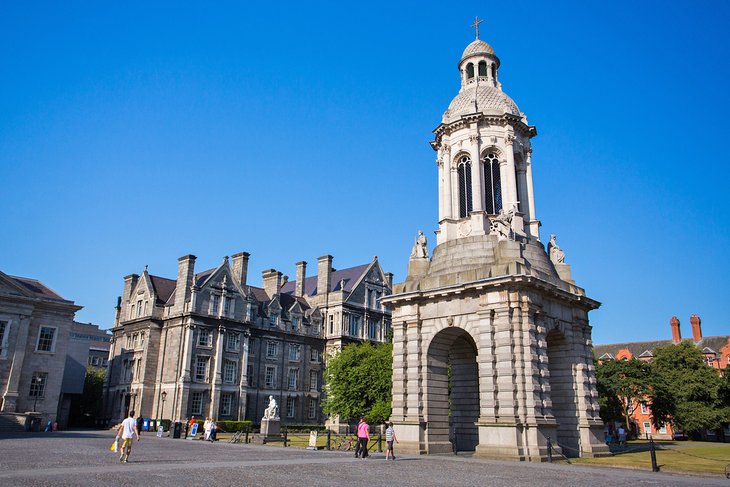
Grand library location for illuminated illustrations of the Christian Gospels dating from 800AD.
The illustrations and ornamentation of the Book of Kells surpass that of other Insular Gospel books in extravagance and complexity. The decoration combines traditional Christian iconography with the ornate swirling motifs typical of Insular art. Figures of humans, animals and mythical beasts, together with Celtic knots and interlacing patterns in vibrant colours, enliven the manuscript’s pages. Many of these minor decorative elements are imbued with Christian symbolism and so further emphasise the themes of the major illustrations.
The manuscript today comprises 340 leaves or folios; the recto and verso of each leaf total 680 pages. Since 1953, it has been bound in four volumes, 330 mm by 250 mm (13 inches by 9.8 inches). The leaves are high-quality calf vellum; the unprecedentedly elaborate ornamentation that covers them includes ten full-page illustrations and text pages that are vibrant with decorated initials and interlinear miniatures, marking the furthest extension of the anti-classical and energetic qualities of Insular art. The Insular majuscule script of the text appears to be the work of at least three different scribes. The lettering is in iron gall ink, and the colours used were derived from a wide range of substances, some of which were imported from distant lands.
This book contains the harmony of the Four Evangelists according to Jerome, where for almost every page there are different designs… and other forms almost infinite… Fine craftsmanship is all about you, but you might not notice it. Look more keenly at it and you will penetrate to the very shrine of art. You will make out intricacies, so delicate and subtle, so exact and compact, so full of knots and links, with colours so fresh and vivid, that you might say that all this was the work of an angel, and not of a man.
3.Killarney National Park and Muckross House & Gardens
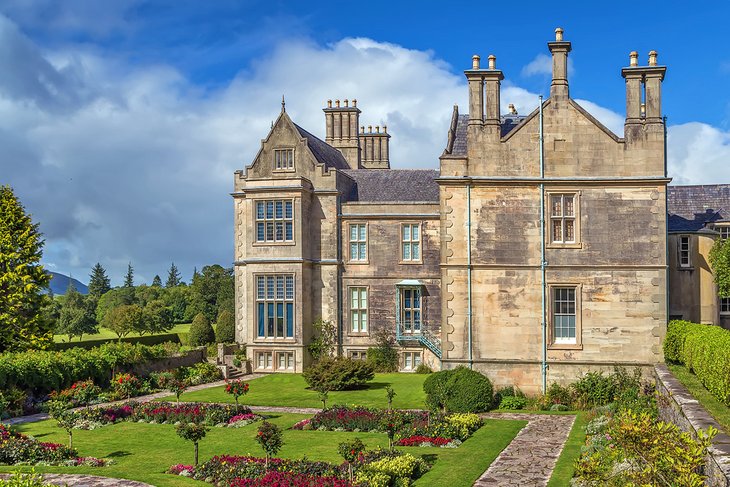
Furnished 19th-century mansion set among mountains and woodland, with shop, cafe and working farms.
Muckross House is a mansion designed by the British architect, William Burn, built in 1843 for Henry Arthur Herbert and his wife, the watercolourist Mary Balfour Herbert.
With sixty-five rooms, it was built in the Tudor style. Extensive improvements were undertaken in the 1850s in preparation for the visit of Queen Victoria in 1861. It is said that these improvements for the Queen’s visit were a contributory factor in the financial difficulties suffered by the Herbert family which resulted in the sale of the estate. In 1899 it was bought by Arthur Guinness, 1st Baron Ardilaun who wanted to preserve the dramatic landscape. He did not live in the house himself, but rented it out to wealthy groups as a hunting lodge.
Standing close to the shores of Muckross Lake, one of three Killarney lakes famed worldwide for their splendor and beauty, this former mansion oozes the grandeur and gentility of bygone days. When exploring, bear in mind that Queen Victoria once visited here. In those days, a royal visit was no small affair; extensive renovations and re-landscaping took place in preparation, and no detail was left to chance.
4.The Ring of Kerry

he Ring of Kerry is a scenic drive around the Iveragh Peninsula in southwest Ireland’s County Kerry. Its 179km-long, circular route takes in rugged and verdant coastal landscapes and rural seaside villages. Skellig Michael, a rocky island with an abandoned 7th-century Christian monastery, is a major destination point, with several boats from Portmagee making the 12km crossing during the warmer months.
“The Ring” is a popular day trip and numerous bus companies offer circuits during the summer months. As the narrow roads make it difficult for tour coaches to pass one another, all tour buses run in an anti-clockwise direction, travelling via Killorglin first. Some recommend that car owners travel in the opposite direction, going first to Kenmare to avoid delays caused by tour buses. Others advise travelling counter-clockwise to avoid having to pass the buses. In 2008 satellite navigation systems were blamed for directing bus drivers in a clockwise direction around the route.
There are numerous variations to the route taking in St. Finian’s Bay and Valentia Island which the official driving ring misses (the official cycling route takes in Valentia Island). As well as beaches, it also offers the Gap of Dunloe, Bog Village, Derrynane House, the Skellig Experience Valentia Island, Moll’s Gap, Torc Waterfall, Muckross House, and Ross Castle.
The entire journey non-stop could take under three hours, but that’s unlikely to happen. En-route there’s a feast of jaw-dropping Atlantic Ocean views, stunning islands to visit, wild sweeping mountains, and many picturesque villages.
5. Powerscourt House and Gardens
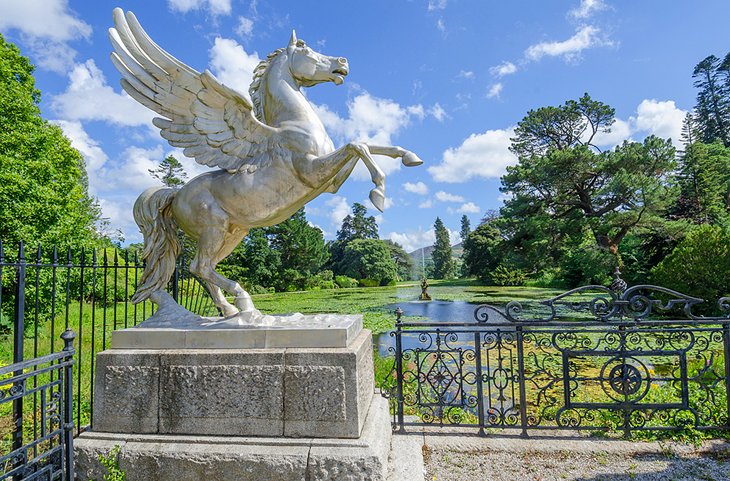
Powerscourt Estate, located in Enniskerry, County Wicklow, Ireland, is a large country estate which is noted for its house and landscaped gardens, today occupying 19 hectares.
Powerscourt Waterfall and its surrounding valley are also owned by the Powerscourt Estate, although the two pieces of land are no longer directly connected. At 121 metres (397 ft), it is the second highest waterfall in Ireland. In 1858, The 7th Viscount Powerscourt established a deer park around the waterfall, resulting in the successful introduction of the Japanese Sika to Ireland.
The house was used as a filming location most famously in Stanley Kubrick’s Barry Lyndon, which was filmed there before the 1974 fire.
The Slazenger family invited Lynn Garrison to relocate his aerial film unit, aircraft collection and hangars, from Leixlip to the Powersourt airfield in 1973. The collection featured in Irish productions, including the Blue Max, Darling Lili, Zeppelin and Von Richthofen and Brown. It remained here until 1981.
Superb views, serene lakeside walks, engaging history, and the stunning backdrop of Sugarloaf Mountain are just some of the treats in store when visiting this magnificent home, just 20 kilometers from Dublin.
Now owned by the Slazenger family, the house is set on 47 manicured acres. Take time to stroll through the Rose and Kitchen Gardens and explore the beautiful Italian Gardens.
6.The Rock of Cashel
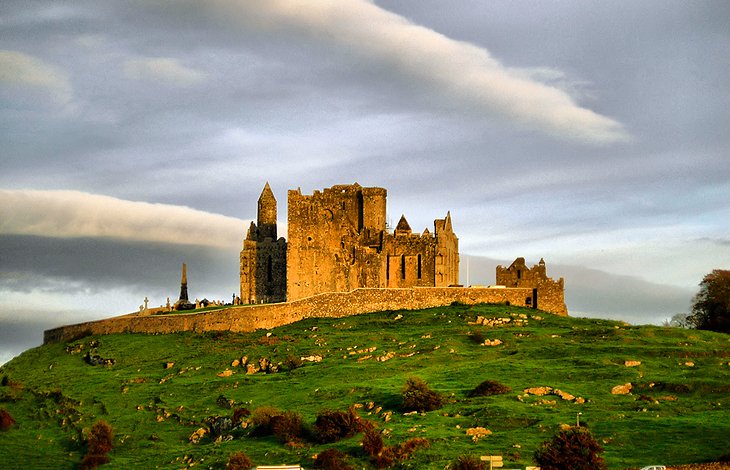
The Rock of Cashel, also known as Cashel of the Kings and St. Patrick’s Rock, is a historic site located at Cashel, County Tipperary, Ireland.
According to local legends, the Rock of Cashel originated in the Devil’s Bit, a mountain 20 miles (30 km) north of Cashel when St. Patrick banished Satan from a cave, resulting in the Rock’s landing in Cashel. Cashel is reputed to be the site of the conversion of the King of Munster by St. Patrick in the 5th century.
The Rock of Cashel was the traditional seat of the kings of Munster for several hundred years prior to the Norman invasion. In 1101, the King of Munster, Muirchertach Ua Briain, donated his fortress on the Rock to the Church. The picturesque complex has a character of its own and is one of the most remarkable collections of Celtic art and medieval architecture to be found anywhere in Europe.Few remnants of the early structures survive; the majority of buildings on the current site date from the 12th and 13th centuries.
The restored Hall of the Vicars Choral is also among the structures. Tourist attractions include an audio-visual show and exhibitions. It’s also said that this was once the seat of the High Kings of Munster prior to the Norman invasions.
he entire plateau on which the buildings and graveyard lie is walled. In the grounds around the buildings an extensive graveyard includes a number of high crosses. Scully’s Cross, one of the largest and most famous high crosses here, originally constructed in 1867 to commemorate the Scully family, was destroyed in 1976 when lightning struck a metal rod that ran the length of the cross. The remains of the top of the cross now lie at the base of the cross adjacent to the rock wall.
7.Kinsale, Co. Cork
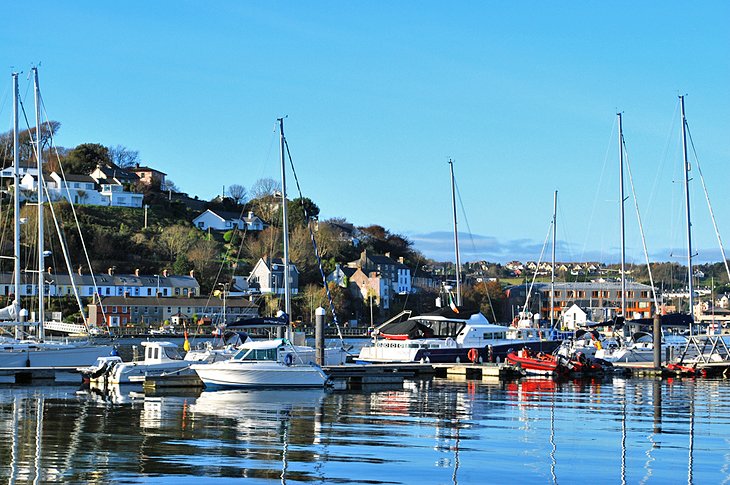
Kinsale is a town on the southern coast of Ireland, in County Cork. Two 17th-century fortresses overlook the River Bandon: the vast, star-shaped Charles Fort to the southeast, and the smaller James Fort on the river’s opposite bank. The 16th-century courthouse building houses the Kinsale Regional Museum, with a variety of displays on local history and information about the 1915 sinking of the RMS Lusitania.
As a historically strategic port town, Kinsale’s notable buildings include Desmond Castle (associated with the Earls of Desmond and also known as the French Prison) of c. 1500, the 17th-century pentagonal bastion fort of James Fort on Castlepark peninsula, and Charles Fort, a partly restored star fort of 1677 in nearby Summercove. Other historic buildings include the Church of St Multose, (Church of Ireland) of 1190, St. John the Baptist (Catholic) of 1839, and the Market House of c. 1600.Kinsale is in the Cork South-West (Dáil Éireann) constituency, which has three seats.
The town has a decidedly Spanish feel, particularly in summer. This is hardly surprising bearing in mind that in 1601, three years after the defeat of the Spanish Armada, the Spanish sent a military force to Ireland, most of whom disembarked at Kinsale. This led to the English laying siege to the town and ultimately the defeat of Spanish and Irish forces by superior English military might.Kinsale is now a magnet for those who love sailing, walking, fishing, marvellous scenery, and great food.









